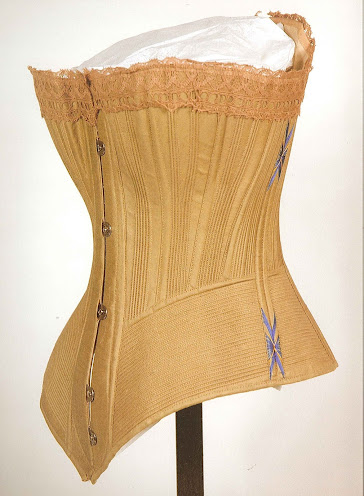This Has Been A Paper View Program
The corset I will make for this project is a reproduction of an extant corset in the Symington Corset collection. The Symington Company of Leicester, England manufactured corsets and undergarments from the 1850s to the 1950s. Because most of their patterns and extant corsets were kept by the company in their original condition, we have a treasure trove of information about how these items were constructed. It's a dream come true for folks like myself. A lot of the patented corset designs are digitized and available online as are pictures of the finished garments. While the specific corset I will recreate is not included in the digital pattern images, I still think it is useful to see the intricate shapes and how the positioning of the pattern pieces on fabric prior to cutting them out makes such a difference in the overall structure.
One of Symington's most popular designs was the "Pretty Housemaid" which was produced starting in 1890. It was marketed toward domestic working-class women who wanted to attain the popular wasp-waisted shape of the time while also holding down their demanding jobs cleaning and cooking for wealthier Victorians. Advertisements for the Pretty Housemaid claimed it was, "the strongest and cheapest corset ever made."
To hunt down a proper recreation of the chosen pattern I turned to a book by Jill Salen called "Corsets: Historical Patterns and Techniques" which quickly became my holy grail. Salen did everyone in the historical clothing community a huge solid by going to various museums including the Symington Collection Archives and measuring out each and every pattern piece for dozens of extant stays and corsets including the one I chose and copying them onto graph paper. She basically conducted a forensic postmortem on this garment to reverse engineer how it was made. It's fabulous.
 |
| Photo by Jill Salen |
Accessibility to this specific corset for ladies on a budget was a huge part of the Pretty Housemaid's commercial success as it was so affordable, fashion-forward, and allowed the wearer flexibility. I chose to recreate it because of its significance in everyday women's lives. The desire for a cross between form and function in this corset design is relatable even today. We may no longer wear corsets regularly (unless you do, I don't know your life) but we have similar quandaries when finding clothing today. that ticks all the boxes of being fashionable, affordable, comfortable, and practical.
The Pretty Housemaid and many other late-Victorian corset designs rely on a largely unknown structural component: cording.
Whalebone and steel were still employed in shaping a corset but not to the extent you would think for the nineteenth century. You can see in the image above that boning channels run vertically and kind of bookend each pattern piece, and occasionally run in between the rows of cording. But this corset has considerably more cording than boning. Theoretically, cording allows for greater freedom of movement in corsetry. This is perfect for when you have to tend the fireplaces and scrub the floors during the day and go to the dance hall with the girls in the evening.
This corset in particular also plays a sneaky little illusion on the eye. You'll notice the bottom of the corset flares out at the hips. The front especially is curved almost as if it was made to accommodate a little post-Thanksgiving dinner belly and this is actually genius. With the right amount of shapewear and strategic padding, larger hip and bust measurements could make the waist look smaller in proportion.
Tightlacing was very much associated with upper-crust women. And even within that small demographic, only a few ladies were partaking in the trend of trying to get as tiny a waist circumference as possible. So it's no wonder padding was used to fill out the hips and make the waist look smaller without the trouble of applying impractical pressure on the torso. The Victorians were busy. Cultural fainting was not on the to-do list for almost everyone. I'll have to make a separate post about corset misconceptions because spoiler alert, y'all have been lied to about clothing this whole time. Stay tuned for that adventure.
Moving on with the word vomit!
This one's for you, Bernadette Banner. Her videos on Youtube about victorian corsetry inspired a lot of this project and I owe her a massive thank you. If the Chicago Manual of Style had an annotation just for Youtube videos, my bibliography would read "Banner, Bernadette" and a URL to her corset series for maybe the first five lines. I highly recommend her channel for all things nineteenth/twentieth-century clothing. She is highly knowledgeable and specializes in historically accurate reproductions to where most of her projects from eras before the invention of the sewing machine are hand-sewn.
Miss Banner has a video about drafting a corset pattern in which she prints out the small-scale pattern pieces, cuts them out, and tapes the seams together where they would normally be sewn and the results are amazing. With paper alone, the structure provided by the curves in the pattern is stunning.
I did the very same out of interest. Here's what happened.






Comments
Post a Comment
Please let me know if you have any comments or questions about my project! I'd be happy to answer them.